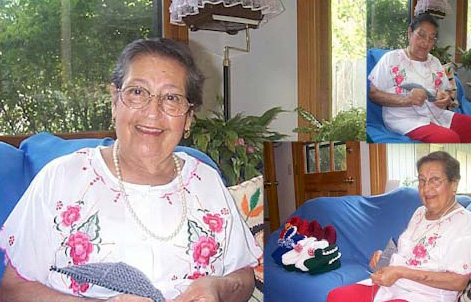
The gifted Angelica Larnia Estratti was born in Negritos, a tiny port city near Talara in the Northern Peruvian province of Piura on October 23, 1920. With almost 80 years behind her, Angelica has lived a life marked by love, laughter, creativity and hard work.
“I was the eldest child of 9. My brother Carlos and I took care of the entire family. There were seven younger brothers and sisters to take care of and we were very poor. My mother was a tailor who sewed for the Americans who were there with the petroleum companies. My mother would sew the uniforms for the petroleum engineers and the workers. She was very, very busy trying to make ends meet and so, as the oldest, I needed to cook, sweep, send the little kids to school and take care of everything in the house. There was a lot of work.
When I was 15, I married Don Julio Larnia, a 36 year old Italian who had come to Peru from the tiny town of Favale di Malvaro in the mountains near Genova, and together we moved to the city of Piura. We had a total of eight kids: Yolanda, Benito, Mafalda, Alvina, Julio, Rosita, Lina and Giovanni.
Don Julio was a smart man and within time, he started a small bodega in Piura called the Bodega Genova. The bodega grew in fame and he hired a group of breadmakers from Lima, two Italian cooks and two Peruvian cooks and an assistant, the famous Ramaicuna.
In those times, there were Germans, Spaniards, Italians, Australians, Japanese and Americans all over Piura. A bunch of Americans had come with a contract from the government to build a huge dam to have water for the valley of Piura to grow cotton and rice. And a lot of Italians came to build the roads in the North of Peru. Woo, those Italians! When they arrived to Piura, they would always ask, “Who’s the oldest Italian man in town?” Everyone would say “Don Julio Larnia!” Go to the Bodega Genova and you’ll find him. And they would come and eat, talk, sleep, and those that didn’t even have pants, Julio would give it to them. And he would let them sleep there and he would bring them into his extended family.
And those Italians were experts in making the women fall in love with them, much better than the Germans and the Americans. My beautiful sister Nelly fell for and was married to Mario Pietrantoni – this Italian dream of a man. Then my other sister Diosa swooped up Mario’s enormous cousin Bruno.
Those were the days! Every night we had music in the bodega. It was a reunion spot for all the Italians in Piura. We would play opera and enjoy the incredible food that we prepared.
There was this old man that arrived from Calabria, one of the toughest places in Italy. His name was Don Antonio Calabrese. He was a man with a shiny bald head that carried a machete everywhere he went. He even slept with that machete. He was the toughest man around and he became Julio’s best friend. Julio would send him to the bank to deposit the money because he was so tough nobody would mess with him. The Peruvians loved to joke with him though. The bankers loved to tease him because he was so easy to rile up and they loved to hear him cuss them out in Italian. They would call out laughing, “Bongiorno Don Antonio Calabrese. Que se dice?? Que se dice?”
“Merda! Merda se dice!!” he would roar, threatening them as they bawled over his Italian-Spanish accent.
I remember playing so many tricks on that tough old guy too! One day I was cleaning the bathrooms and I got so mad because that damn Don Antonio never flushed and would leave such a stinky mess in the bathroom. I was so mad because it always happened, so I went to the market and bought the strongest hot sauce that they sell in the North. It was so hot only a few people around could actually eat it. So, I bought a whole jarful and right before Don Antonio’s daily trip to the bathroom, I went into the bathroom and wiped a large center stripe down the entire toilet paper. Carefully placed so he wouldn’t touch it with his hands and positioned right where I wanted it!
So I waited in this tiny hiding spot, and sure enough Don Antonio went in there. He took a long time and then suddenly I heard this thunderous roar. “Aarggh!!! Aarggh!!!” and the door slammed open with Don Antonio in a rage, his face purple, his pants down and his machete in hand. He kept screaming “Aarggh!!! Aarggh!!!” until Jose, the chef’s assitant, came running to see the naked Don Antonio who howled, stumbling around, “Arde el culo!! Arde el culo!! Aarghh!”
Showing him his red rear-end while waving his machete, Don Antonio demanded, “Was this you?!” Jose, paralyzed, asked him to go to the shower and wash it out. So the pained Don Antonio limped to the bathroom and you know what? He never again used the bathroom in the bodega.
I know I’ll pay for that one later, but it was worth it. And that was only one of the jokes I played on him. He loved to smoke. And if anyone left their cigarettes around, he would grab them, and people were too scared to ask for them back from the ferocious Don Antonio. So, one day I bought some firecrackers – you know the really loud ones – and I grabbed a pack of cigarrettes. I unrolled each one of them and placed a firecracker in each of them.
That night, when everyone was together in the bodega, I left the pack near him, and sure enough he glanced around and grabbed one of the cigarettes. I carefully watched him as he took a few puffs. Then suddenly when he sucked in, the fuse lit and the firecracker exploded in his mouth. BOOM! And his entire shocked face was left black. “What happened Don Antonio?” everyone asked and he just screamed out “Merda! Merda!” his eyes bulging with anger. And I never saw him steal another pack of cigarettes from that day. I loved playing with him, and I would never tell you that it was me, if he wasn’t safely beneath the earth.
One day, Don Antonio came to Julio and he asked him, “Don Julio, I’m getting old, and I want to go back to our land to die.” Julio took care of him – he was sad to see his good friend go, but he bought him a passage, gave him some money and sent him back to Calabria.
Later, Julio and I put a restaurant in the Plaza Merino, named after the artist Merino, and the people really went crazy for that Italian food. Every Sunday especially. We would sell tallarines, gnochis, canelones, raviolis, and people would come with their fancy cars and sometimes take ten, fifteen plates home with them after they finished. And we made an incredible Peruvian ceviche which would drive them crazy too!
I really remember Ramaicuna, the assistant chef. He loved to make a show, making the beef steaks jump high up in the air on the grill. What skills he had! He would have fun when the Peruvian chefs were in the kitchen, but when the Italians would begin to cook, they would kick all of the Peruvians out. They didn’t want us to see their secrets. But Ramaicuna was smart, and he observed out of the corner of his eye, especially when he would go in to make the ravioli sauce for them. I would watch too, and I learned quickly. I would ask them if they wanted help grinding the vegetables. They hated doing that, because it was a lot of work. They would take my ground vegetables and fill in the raviolis with it. I would secretly watch and that’s where I learned to cook my hand-made Italian meals.
We worked so hard though. We worked, worked, and never rested. In the early 70s, one night, when Julio was asleep, a young Argentine came and rang his doorbell. He said he needed to buy a lot of ham to take with him, so Julio, who was the type of man that wasn’t scared of anyone, let him in. The young guy pushed Julio back against the bathroom and, after getting the key to the safe, he used a brick and slammed Julio over the head, killing him. What kind of evil man was this guy? Killing a 78 year old man in cold blood with a brick over the head? I can’t even imagine it.
The next day, when Julio was discovered, the entire Piura went up in arms over the loss of their beloved Don Julio. Almost immediately, the Argentine was discovered trying to get a rush visa to travel somewhere. He was sentenced to 25 years in prison.
After some years there in the North of Peru, I decided to go stay with my daughter Rosita who was living near Stanford University with her husband who was getting his doctorate. Rosita, who later became an award winning bilingual kindergarten teacher in San Antonio, would take care of eight or nine kids at her home, so I helped her in that. That is about the time that I learned to make the botines (pronounced bo-teen-es). When my sister Nelly went to the hospital, she saw a woman sewing these little botines and she learned from that woman. When she came home, she told me, “You won’t believe what I learned to do in the hospital?” I asked what? And she said, “Botines!” “Oh, yeah?” I asked. “Teach me.”
And so I learned right there from Nelly. I learned fast. It was almost like I was born to make these botines. I was so excited. I started making them and people really like them. I got better and better, and I started experimenting with new colors, mixing colors, and I added the pompom on top that people really liked.
When we moved to San Antonio, Texas, I made 20 botines for the kids in Rosita’s kindergarten class. And then the teachers asked for them, so I made 15 more and then Robert, Rosi’s husband, asked for 10 more for the secretaries in his University of Texas department.
And since then, I’ve made thousands of botines. Thousands! I’ve sent them to Spain, Australia, Peru, New York, all over. I’ve made them for the Methodist churches. I’ve given them to the elderly at a retirement home to keep their feet from getting cold. I even sent them to Brazil for the family as a gift when my grandson was married there.
I start with the part on top and I finish with the tiny piece in the toe area. At the widest point, there are 44 stitches and at the smallest 9 stitches. They really stretch, so big men can use the same pair as little kids. I’m now experimenting with baby botines – in pink, yellow and blue – and I’ll send them to Novica. They’re going to be really cute I hope. I love colors, especially bright ones.
Once in Spain, a millionaire woman asked me to make her a pair in white. White?! Why white? I thought. They would get dirty. But I made them and I put a pink and white pompom and the woman loved them. She wrote me and told me that she uses her botines every day. Even to sleep!
Its become a little harder now with the dialysis. I’ve lost part of the use of my left hand on days that I have dialysis, but on the other days I can make them.
When I was 40, I found out that I had diabetes. I had to watch what I ate, you know – not eat any sweets and all that. Over time, my kidneys became weaker and weaker. About three months ago, in June of 1999, the doctors told me that I had to begin dialysis. They said I only had about 10% of the use of my kidneys. It really affected me, because I already had plane tickets to see my grandson get married in Rio de Janeiro. I said, “Ayy! What can I do?! Well, I guess I better get on that machine. That machine will make me better.” And sure enough, the dialysis brought my appetite back and makes me feel stronger.
I go three times per week – Monday, Wednesday, and Friday. The first time they did it, they told me “we can see you’re a very strong woman. You’re going to be fine with the dialysis.” And sure enough, it didn’t hurt me at all. Well, sure, the first part where they stick the needle in you hurts a bit, but it wasn’t so bad. The worst thing is to have to be laying down so long. Its nice because they put all of us Spanish-speakers together so that we can talk to each other.
There’s one woman, Josefina, who’s been in dialysis there for 14 years and knows the lives of everyone. So we all get together, and tell jokes, and the ladies say, “send the men over there on the other side. And put us near Angelica” — I guess because I make them laugh. But really, Josefina is the funny one. She’s younger, only about 65 years old, and she lifts her skirt and says “see these legs! These are for dancing!” And she goes out every night dancing with her boyfriends. She says, “See the postman over there. He’s my boyfriend too!” And then they begin to tease me about boyfriends, even though I don’t have any!”
And that is only but a small piece of the life of the wonderful Angelica Larnia. She was known to say, “For everyone that buys my botines, I want to let them know that they are made with a lot of love. Muchisimas Gracias.”
Larnia is also survived by three sons, Benito Larnia of Trujillo, Peru, Julio Larnia of Rochester, N.Y., and Giovanni Larnia of Piura, Peru; four other daughters, Yolanda Garcia of Adelaide, Australia, Mafalda Mazan of Cordoba, Spain, Alvina Rita of Miami and Lina Nava of Piura, Peru; 24 grandchildren; and 28 great-grandchildren.





